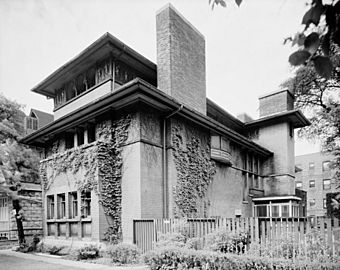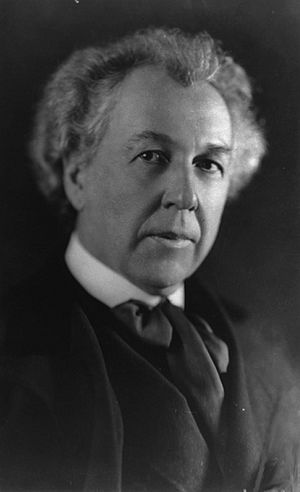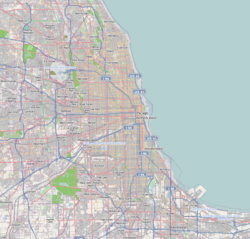Heller House facts for kids
|
Isidore H. Heller House
|
|

A view of the east (front) and north elevations of the Heller House.
|
|
| Location | 5132 South Woodlawn Avenue, Chicago, IL, United States |
|---|---|
| Built | 1897 |
| Architect | Frank Lloyd Wright |
| NRHP reference No. | 72000450 |
Quick facts for kids Significant dates |
|
| Added to NRHP | March 16, 1972 |
| Designated NHL | August 18, 2004 |
The Isidore H. Heller House is a famous house located at 5132 South Woodlawn Avenue in the Hyde Park area of Chicago, Illinois, United States. This special house was designed by the well-known American architect Frank Lloyd Wright. It's considered a very important building because it shows a big change in Wright's style. He started moving towards what is called Prairie School architecture.
Prairie School buildings often have:
- Horizontal lines that make them look wide and low.
- Flat or gently sloped roofs with wide parts hanging over the edges (called eaves).
- Windows grouped together in long, horizontal bands.
- Designs that blend in with the natural landscape, like the wide-open Prairie lands.
The Heller House shows that Wright was moving away from the style of his teacher, Louis Sullivan. A sculptor named Richard Bock, who worked with Wright, added some decorations, including a special plaster design called a frieze. The house is located near other buildings designed in the Prairie School style. This helps us see how the Heller House fits into all of Wright's amazing work. The Heller House was named a Chicago Landmark on September 15, 1971. It was added to the National Register of Historic Places on March 16, 1972. Later, on August 18, 2004, it was even named a National Historic Landmark by the U.S. Department of the Interior.
Contents
History of the Heller House
Not much is known about Isidore H. Heller and his family. We have learned some things from old interviews and official records. Isidore Heller was born in Austria in 1847. His wife, Ida, was born in Wisconsin in 1857. In America, Mr. Heller worked for a company that supplied things for meat packers.
Building the House
Mr. Heller bought land in the Hyde Park area of Chicago on January 2, 1895. He then asked Frank Lloyd Wright to design his house in 1896. A building permit was given on July 13, 1897. It cost only $7.70 to get the permit! William Adams was the builder. The house was built in 1897 on a lot that was about 50 feet wide and 175 feet long (about 15 by 53 meters). The total cost to build the house was around $12,500. In 1906, Mr. Heller bought an extra 25 feet (about 7.6 meters) of land next to his house to make the lot bigger.
Who Lived Here?
The Heller family lived in the house for about 16 years. Ida Heller passed away on October 11, 1909. The house was then sold to Francis Bickett on June 18, 1913. Bickett sold the house within a year to Charles McFarlane. From 1924 to 1939, Joseph Mayer and his wife owned the house. Local people even started calling it the "Joseph Mayer House."
In 1939, the Mayers sold the house to Mr. and Mrs. Wilfred Fox. They reportedly made some changes to the third floor of the home. George Watson bought the house from Fox in 1948. He owned it for 25 years, longer than anyone else! Lewis Bradford bought the house in 1972. He had the outside of the house cleaned by sandblasting.
In 1977, Victor and Danielle Barcilon bought the house. They lived there until 1987. Then, David and Catherine Epstein bought it. They sold the house to Serafino Garella and Judith Bromley in 1995. They did some great work, restoring a bathroom and the fireplace in the main bedroom. The house was named a National Historic Landmark that same year. The Goldstein family bought the house in 2004.
Architecture and Design

When Wright designed the Heller House in 1896, it showed a big change in his work. He started moving away from older styles and towards more modern, geometric designs. The Heller House shows how Wright was influenced by his teacher, Louis Sullivan. It also shows Wright's first steps towards the Prairie School homes that would become famous.
You can see Sullivan's influence in the flower patterns on the plaster frieze on the third floor. This frieze was made by Richard Bock. Sadly, during some cleaning work in the 1970s, much of the detailed design on the frieze was damaged.
Building Materials and Shape
The Heller House is about 26 feet wide and 98 feet long (about 8 by 30 meters). It stands 41 feet (about 12.5 meters) high. It was built using Indiana Limestone and yellow Roman brick. These materials help to show off the geometric and horizontal look of the house's outside.
The house was built on a narrow piece of land. Because of this, the main entrance is on the side of the building. This is similar to another house Wright designed in 1892. The entrance on the south side has some fancy Classical details. The stone beam above the entrance, called a lintel, sticks out without support (it's cantilevered). It rests on two decorated stone columns. This lintel was decorated with special four-leaf shapes called quatrefoils. The main living room inside is not divided by a hallway, which makes it feel very open and spacious.
Why the Heller House is Important
The Heller House was the first building Wright designed in the Hyde Park neighborhood of Chicago. This area was known for its Gothic Revival buildings, designed by architects like Henry Ives Cobb. The Heller House mixes important parts of Wright's Prairie style. It is also located very close to other early works by Wright. For example, Wright's famous Robie House is only six blocks away. The Blossom House and McArthur House are also nearby in Kenwood.
Many of the houses in Hyde Park have beautiful gardens. The neighborhood has been going through a big renewal project since the late 1950s. Hyde Park grew very quickly after it became part of Chicago in 1889. The University of Chicago was started there in 1892, and the Columbian Exposition (a big world's fair) happened there in 1893. When the Heller House was built, its design was very different from any other home in Chicago. Some people even called it Wright's most "outrageous" design at the time!


